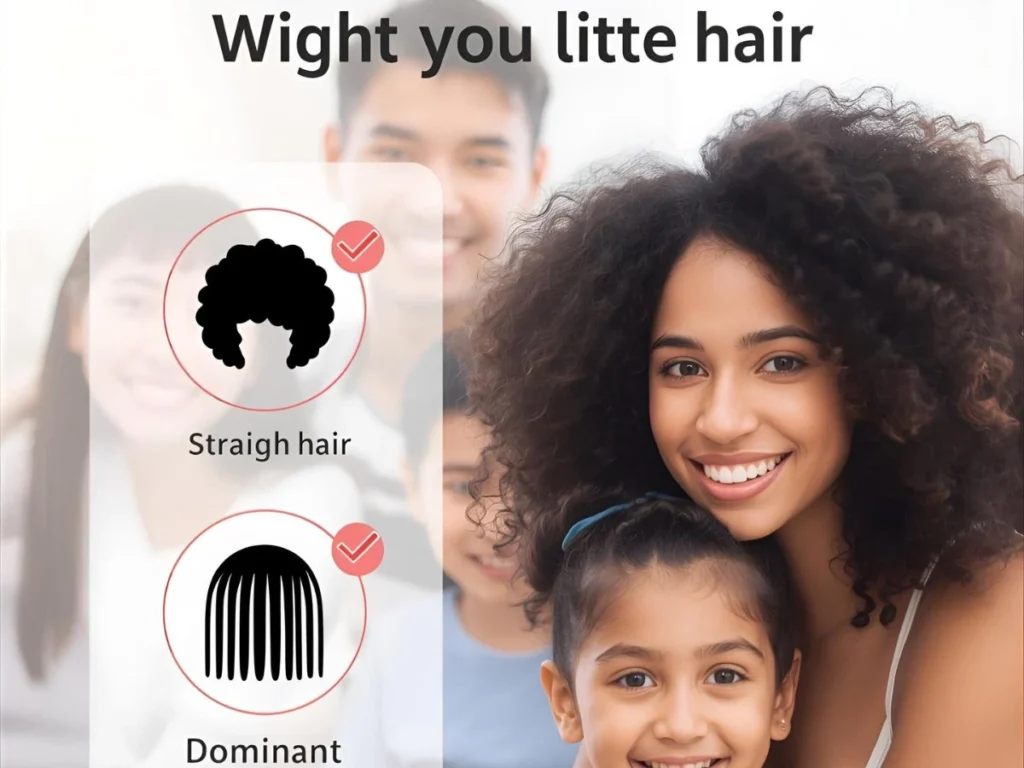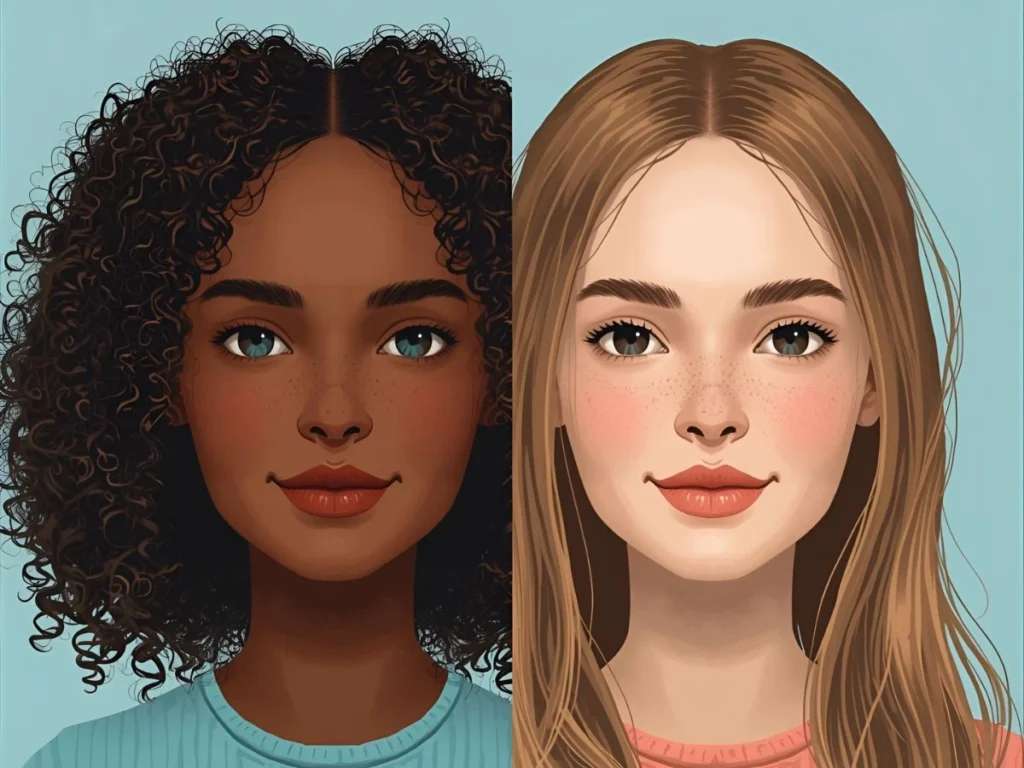Ever wondered why some people have curly hair while others have straight?
Hair genetics isn’t as simple as one gene “winning.”
Curly hair can be dominant, recessive, or influenced by multiple genes.
In this article, we’ll explain how it’s inherited and what that means.
We’ll also clear up common myths about curls and straight hair.
By the end, you’ll understand why your hair looks the way it does.
Is Curly Hair Dominant or Recessive? – Quick Answer

Curly hair is generally considered dominant over straight hair, but it’s not that simple. Hair texture is controlled by multiple genes, not just one.
For example, if one parent passes a “curly” gene (dominant) and the other a “straight” gene (recessive), the child is likely to have curly or wavy hair. However, variations in gene expression can lead to wavy or mixed textures. Think of it like a recipe: curly genes often take the lead, but other ingredients (genes) can tweak the outcome.
The Genetics Behind Curly Hair
Hair texture is determined by genetics, specifically by genes like TCF7L2 and others that influence hair follicle shape. Curly hair results from oval or asymmetrical follicles, while straight hair comes from round ones.
These genes follow Mendelian inheritance patterns, where dominant traits (like curly hair) tend to show up even if only one parent passes the gene.
Recessive traits (like straight hair) need both parents to contribute the gene. However, hair texture is polygenic, meaning multiple genes interact, which is why you might see wavy hair or varying curl patterns in families.
Dominant vs. Recessive Traits: How They Work

Dominant traits, like curly hair, express themselves when at least one dominant allele is present (e.g., CC or Cc). Recessive traits, like straight hair, only appear if both alleles are recessive (cc). Here’s a comparison:
| Trait | Dominant (Curly) | Recessive (Straight) |
|---|---|---|
| Allele Needed | One (CC or Cc) | Two (cc) |
| Expression | Shows with one copy | Needs two copies |
| Example | Curly or wavy hair | Straight hair |
| Likelihood | More common | Less common |
For example, if a curly-haired parent (Cc) and a straight-haired parent (cc) have a child, there’s a 50% chance the child will have curly hair (Cc) and a 50% chance of straight hair (cc).
Which Hair Texture Will Your Child Inherit?
Predicting a child’s hair texture depends on the parents’ genes. If both parents have curly hair, the child is likely to have curls (CC or Cc). If one parent has straight hair, the child might have wavy or curly hair, depending on the gene mix.
For global audiences, curly hair is more common in populations with African, Mediterranean, or South Asian ancestry, while straight hair is prevalent in East Asian and Northern European groups. However, mixed ancestry can lead to diverse outcomes. Use a Punnett square for a visual prediction or consult a genetic counselor for personalized insights.
Common Myths About Curly Hair Genetics
People often misunderstand curly hair inheritance. Here are frequent misconceptions and corrections:
- Myth: Curly hair always dominates straight hair completely. Truth: Multiple genes influence texture, so outcomes vary (e.g., wavy hair).
- Myth: If both parents have straight hair, their child can’t have curls. Truth: Hidden recessive curly genes can surface in later generations.
- Myth: Hair texture is set at birth and never changes. Truth: Hormones, age, and environment can alter texture over time.
Curly Hair in Everyday Examples
- Emails: “I’m researching if curly hair is dominant or recessive for a school project. Can you clarify?”
- News: A 2023 study in Nature Genetics explored how multiple genes shape hair texture across ethnicities.
- Social Media: X posts often ask, “Why do my kids have curly hair when mine is straight?”
- Formal Writing: Genetic reports might state, “Curly hair, a dominant trait, appears in 60% of mixed-ancestry offspring.”
Is Curly Hair Dominant or Recessive? – Google Trends & Usage Data

Google Trends data shows high search interest for “is curly hair dominant or recessive” in the U.S., U.K., and Nigeria, peaking during school science fair seasons (September–October). Interest is strong in regions with diverse populations, like the U.S. and Brazil, where hair texture varies widely. On X, users frequently discuss curly hair genetics in parenting and beauty communities, reflecting curiosity about inheritance patterns. Search volume is steady, with related queries like “curly hair genetics” and “hair texture inheritance” trending alongside.
FAQs About Curly Hair Genetics
- Is curly hair always dominant? No, curly hair is generally dominant, but multiple genes can create wavy or mixed textures.
- Can two straight-haired parents have a curly-haired child? Yes, if both carry a recessive curly gene, their child could inherit curls.
- Does hair texture change with age? Yes, hormones, aging, or treatments can alter hair texture over time.
- Is curly hair more common in certain populations? Yes, it’s more prevalent in African, Mediterranean, and South Asian groups.
- Can environment affect hair texture? Humidity and hair care can influence appearance but not the genetic trait.
- How do I predict my child’s hair texture? Use a Punnett square or genetic testing for likely outcomes.
- Are wavy and curly hair the same genetically? Wavy hair often results from a mix of curly and straight gene variants.
Conclusion
Understanding whether curly hair is dominant or recessive answers a common question about how traits pass through families. Curly hair is generally dominant, meaning it often shows up if even one parent passes the gene. However, hair texture is complex, influenced by multiple genes, which can lead to wavy or mixed textures. This explains why siblings might have different hair types or why curls can appear unexpectedly in a family. By debunking myths—like the idea that straight-haired parents can’t have curly-haired kids—this article clarifies the science for students, parents, or anyone curious about genetics. For practical use, tools like Punnett squares or genetic counseling can help predict outcomes. Globally, curly hair’s prevalence varies by population, making this topic especially relevant in diverse regions. Whether you’re planning a family or just love your curls, knowing the genetics behind hair texture empowers you to appreciate its uniqueness. For more details, explore genetic resources or discuss with a professional.



